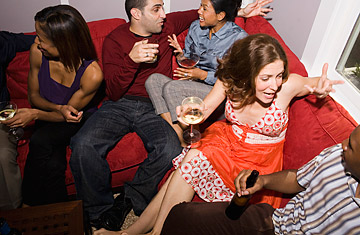
When the going gets tough, the tough, um, go drinking. That's the word from a new Gallup poll showing that 67% of Americans are hitting the bottle, the most since 1985. Another sign of challenging economic times: more and more of those rounds are happening in the kitchen, not at the corner pub.
A new report by Mintel International, a market-research firm, shows that a growing number of Americans are guzzling down wine and spirits at home as opposed to in bars and restaurants, and many are trading down to cheaper brands as they seek fiscally conscious ways to party in a sluggish economy.
"We used to say that [alcohol consumption] was recession-proof or at least recession-resilient, but the rules have changed in this recession," says David Henkes, a vice president at Technomic, a research and consulting firm.
Though the recession technically ended more than a year ago, high unemployment, stagnant wages, falling home prices and shrinking retirement savings have shattered consumer confidence and affected where and how much Americans imbibe, according to the Mintel report. Traffic to restaurants has plunged, with fine-dining establishments taking the biggest hit as businesses pull back on entertaining clients and consumers keep a tighter grip on their pocketbooks.
Sales of alcoholic beverages at bars and restaurants fell 4.6% in 2009, while sales at liquor stores, supermarkets and other retailers for "at home" drinking rose 1.2%, the report said. Americans are gulping 10 drinks on average each month at home, compared with only 5.7 drinks in bars and restaurants, the report notes.
Certain drugstore chains and cash-strapped state governments are trying to cash in on the trend. In the past year, Walgreens has started stocking its shelves with beer and wine, reversing a 15-year ban on alcohol sales.
And in New York, Governor David Paterson is pushing for legislation that would end a 20-year fight to allow grocery stores to sell wine — a move that would generate about $300 million in licensing fees alone. "The governor is one of the big champions of this because they're turning over every rock they can find for revenue right now," says Dan Hendrick, communications director for the New York League of Conservation Voters, an environmental group lobbying for the change as a way to raise revenue. About 35 other states already allow this.
For the booze industry, the surge in retail sales has helped to at least partially offset the decline in restaurant sales. "The suppliers still benefit as long as they're getting the volume," says Raymond Jones, an analyst at Ragen MacKenzie, a division of Wells Fargo Investments LLC.
But penny-pinching consumers are not only avoiding restaurants but also trading down to cheaper alcohol brands to save money, the Mintel study says. At the retail level, consumers have shifted their tastes to the $8-$15 wines, from the $40-$60 class, and demand for lower-priced vodka, such as Svedka, has surged. To the chagrin of suppliers, consumers "are learning they can trade down in price without trading down in quality, especially among wine," says Craig Wolf, president and chief executive of the Wine & Spirits Wholesalers Association.
Suppliers have been taking extra steps to boost sales and protect market share in light of the downturn in restaurant and bar activity. Many are offering price discounts, adding ready-to-drink cocktails in retail stores, hosting wine-tasting events and using celebrities, such as Bruce Willis for Sobieski Vodka and Dan Aykroyd for Crystal Head Vodka, to boost sales. Traditionally, liquor producers rely on bars and restaurants to launch and market new brands, but with traffic down, they're having to find new ways to get people out to the bars "If you have Bruce Willis show up at a major nightclub with Sobieski, people are going to try it out and buy it," says Wolf.
